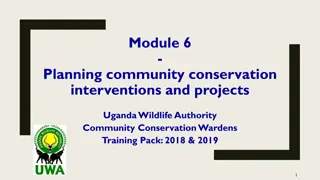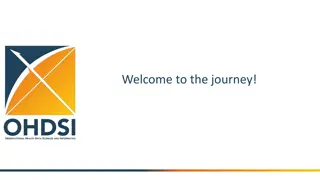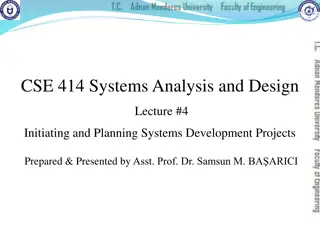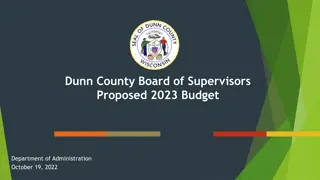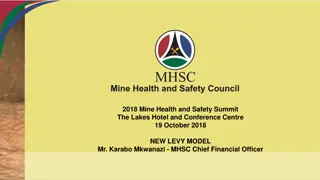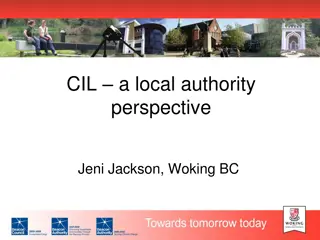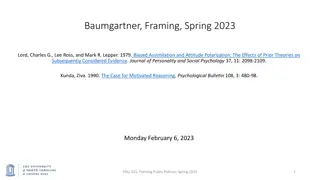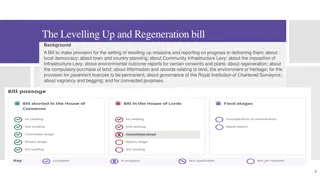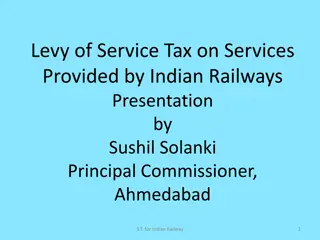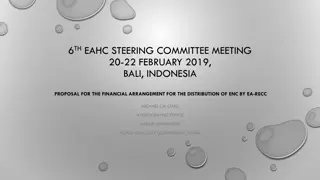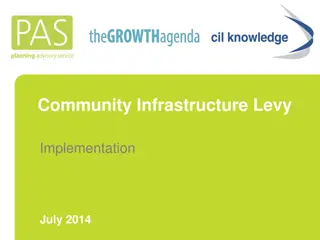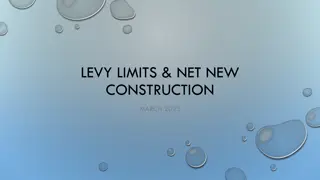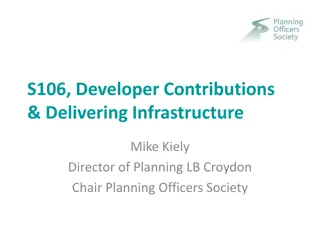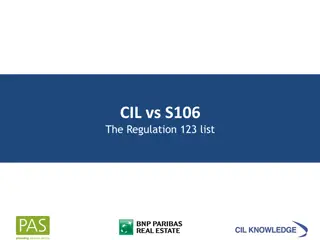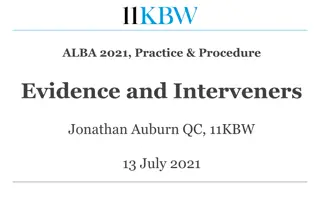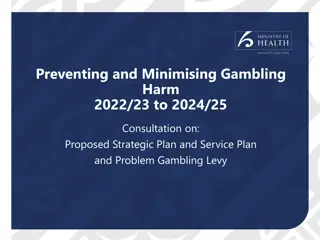Community Infrastructure Levy Project Planning and Infrastructure Evidence
Explore the process of Community Infrastructure Levy (CIL) project planning, learning key insights, setting objectives, selling the benefits of CIL, and understanding the project team structure and resources. Discover the stages and actions involved in CIL implementation, from mobilization to submission. This comprehensive guide sheds light on strategic infrastructure investment, regulatory compliance, and the transparent, upfront costs associated with CIL.
- Infrastructure Levy
- Project Planning
- Community Development
- Strategic Investment
- Regulatory Compliance
Download Presentation

Please find below an Image/Link to download the presentation.
The content on the website is provided AS IS for your information and personal use only. It may not be sold, licensed, or shared on other websites without obtaining consent from the author. Download presentation by click this link. If you encounter any issues during the download, it is possible that the publisher has removed the file from their server.
E N D
Presentation Transcript
Community Infrastructure Levy Project Planning and Infrastructure Evidence July 2014
What have we learnt so far? 1. You need a senior project sponsor and project manager 2. You need to sell the benefits of CIL 3. Keep focused; a CIL examination remains a relatively narrow affair
Setting the objectives, scope and deliverables Objectives, scope and deliverables objectives, scope and deliverables team and resources timeline budget. Team and resources Budget What comes first? Timeline
Selling CIL Members and executives Development market Fellow officers Community Regulations and timing Regulations and timing Regulations and timing Regulations and timing Regulations and timing Regulations and timing Regulations and timing Strategic infrastructure investment to support development Support to strategic planning approach Community projects and reinvestment Likely increase in income Powerful tool to support growth Greater involvement in priority setting Easier to administer Transparent, upfront cost
CIL Project Team and Resources Project Sponsorship Project direction and assurance Project Quality Assurance Project structure and components Project Management Implementation - processes, procedures systems Infrastructure planning and funding gap Planning and regulatory compliance Viability
Model Programme 1 2 3 4 5 6 7 8 9 Mobilisation Preparation of PDCS (min 6 weeks) Consultation of PDCS Preparation of draft Charging Schedule Consultation on draft Charging Schedule and preparation for examination Submission to examiner
Programme Stages, actions and deliverables Preliminary Draft Charging Schedule and Consultation Draft Charging Schedule and Representation Evidence Base Examination and adoption ACTIONS Collate infrastructure planning and cost evidence Prepare funding schedule Prepare development projections Collate viability evidence Prepare working hypothesis charging schedule Assess evidence gaps Fill gaps Procure external support, if required. ACTIONS Finalise evidence base Prepare consultation strategy Prepare statement on Installments Finalise preliminary draft charging schedule Undertake consultation for a minimum period of six weeks Analyse consultation responses and, if necessary, refine evidence base and rates. ACTIONS Prepare draft charging schedule Undertake representation for a minimum six week period Analyse representations s and, if necessary, refine evidence base and rates. Prepare statement of modifications, if required. Prepare information for Examiner ACTIONS Procure a examiner Issue information to examiner and set examination date Undertake examination Receive and review examiners report Prepare adoption report for Full Council Take report and charging schedule to Full Council and gain approval DELIVERABLES Infrastructure and funding analysis that demonstrates a funding gap Development projections by usage (and potentially by area) Working hypothesis charging schedule Estimate of CIL income with sensitivity analysis DELIVERABLES Preliminary draft charging schedule Supporting evidence base Consultation report Updated evidence base DELIVERABLES Draft charging schedule Representation report Statement of modifications (if required) Information for examiner DELIVERABLES Examination Examiners report Report to Full Council
Consultation and representation strategy Two elements: consultation on Preliminary Draft Charging Schedule representation on the Draft Charging Schedule. Our recommendations are: to make the consultation as meaningful and comprehensive as possible whilst containing it within the specified time period and to interested parties; by conducting it in this manner you will draw out and address the significant issues in advance of representation you want the representation to be quick, efficient and contained leading up to the examination.
Typical Project Risks Likelihood of becoming issue Risks Failure at examination due to insufficient evidence base Unlikely Failure at examination due to unreasonable interpretation of viability evidence Unlikely Failure at examination due to incorrect interpretation or application of the regulations Unlikely Discouraging development through poor engagement or inappropriate rate setting Likely Disruption to project timeline due to poor/ inappropriate engagement with members/ senior managers Highly likely Not having the procedures, processes and systems in place for implementation and collection Highly likely
Five key points on successful CIL project delivery 1. CIL is a good news story; sell the project to make life easier. 2. Proper planning prevents poor performance. 3. Resource it properly with the correct expertise. 4. Know the regulations and guidance; there are no shortcuts. 5. Keep it simple and contained.
What have we learnt so far? 1. Still relatively minor component of examinations 2. All councils have an infrastructure funding gap 3. Greater emphasis on CIL vs S106 and double dipping
Infrastructure Funding Gap total cost of infrastructure funding from other sources Residual Funding Gap Aggregate Funding Gap aggregate funding gap projected CIL Income Projected CIL Income/ CIL Target residual funding gap sources Other Total Cost of Infrastructure Funding Funding
Golden thread Relevant Plan Infrastructure Evidence Drawn from infrastructure evidence that underpins the CIL Infrastructure Evidence plan Total cost of infrastructure for projects that are potential Funding Gap Project List candidates for CIL funding Regulation 123 list Regulation 123 List Need to understand approach to S106 and S278
Waltham Forest Case Study 2 (1) Context Adopted Core Strategy in 2012 CS supported by SIP produced 2009 PDCS consultation based on SIP Council commissioned update to support DCS consultation Considerations Should additional infrastructure planning be undertaken for CIL? How to align plan making process to delivery?
Waltham Forest Case Study 2 (2) Approach additional infrastructure planning undertaken in 2013 to align IDP to spending priorities work undertaken during a 12-week intense period. update to viability work undertaken concurrently Outcomes Updated IDP that can inform capital programme Successful CIL examination in spring 2014.
Feedback from examinations Relatively minor part of CIL examinations to date (2-3 paragraphs in the examiners report) Most authorities undertook additional bespoke infrastructure planning for CIL.
Infrastructure Evidence - Questions 1. Have you identified the total cost of infrastructure they wish to fund wholly or partly through the levy? (para.2:2:2:1) 2. In identifying your CIL target, have you considered what additional infrastructure is needed in your area to support development and what other funding sources are available? (para.2:2:2:1) 3. Is your information on infrastructure need directly related to the infrastructure assessment that underpins your plan (para.2:2:2:1)?
Questions www.CILknowledge.com




